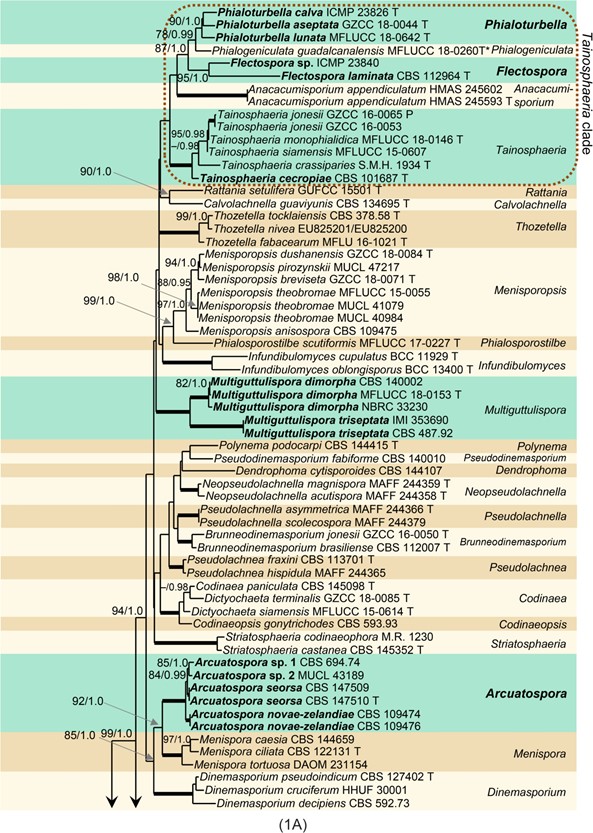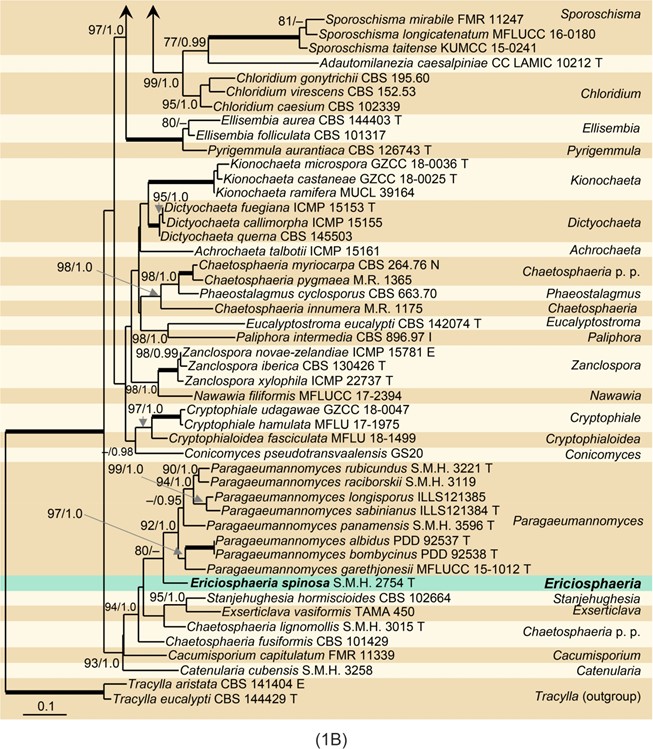Arcuatospora Réblová & Hern.-Restr.
MycoBank number: MB 839474; Index Fungorum number: IF 839474; Facesoffungi number: FoF14543
Etymology – Arcuatus (L) bent, curved into the shape of a bow, spora (L) spore, referring to falcate conidia.
Type species – Arcuatospora novae-zelandiae (S. Hughes & W.B. Kendr.) Réblová & Hern.-Restr.
Description – Colonies on the natural substrate effuse, hairy, mycelium superficial, composed of setose synnemata. Anamorph Setae erect, straight, arise singly from a discoid, pseudoparenchymatous subiculum, dark brown to black, opaque, thick-walled, paler and thinner-walled at the apex, apex sterile, broadly rounded, occasionally terminating into a phialide. Conidiophores macronematous, synnematous, closely bound, parallel, unbranched, brown, synnemata arise around the base of the seta, surrounds the seta, diverge from it towards their apices and become unilateral. Conidiogenous cells integrated, terminal, mono- or polyphialidic, extending percurrently and sympodially, paler than the conidiophores; collarettes subhyaline, cup-shaped or funnel-shaped. Conidia falcate, slightly truncate at the base with a basal scar, 1-septate, hyaline, with a straight or gently curved setula at each end, inserted terminally at the apex, subterminally at the base, conidia accumulate in slimy fascicles. Teleomorph not observed.
Habitat and geographical distribution – Members of the genus are saprobes on decaying leaves, petioles and fruits of various host plants. They have been reported worldwide from freshwater and terrestrial biotopes in subtropical and tropical geographical areas [6,9,63–69].
Note – Phylogenetic analysis of ITS-28S data set indicates that Menisporopsis is a polyphyletic genus (Figure 1). Menisporopsis novae-zelandiae and other four isolates are grouped as a strongly supported clade unrelated to the lineage containing M. theobromae and other species of Menisporopsis. The transversely 1-septate conidia with simple setulae and synnemata surrounding the seta becoming unilateral towards their apices are the main diagnostic characteristics of this newly discovered group. Based on the phylogenetic evidence supported by morphological data, M. novae-zelandiae and four other isolates are segregated into a new genus Arcuatospora.

Figure 1. Cont.

Figure 1. (A) Phylogenetic tree based on the combined ITS-28S rDNA sequences constructed by maximum likelihood (RAxML) of selected members of the Chaetosphaeriaceae. Species names given in bold and placed in green boxes are taxonomic novelties. T, E, I, N and P indicate ex-type, ex-epitype, ex-isotype, ex-neotype and ex-paratype strains; asterisk (*) indicates ex-type of Tainosphaeria obclavata (=Phialogeniculata guadalcanalensis). Thickened branches indicate branch support with ML BS = 100% and PP values = 1.0. Branch support of nodes ≥ 75% ML and ≥0.95 PP is indicated above or below branches. (B) Phylogenetic tree based on the combined ITS-28S rDNA sequences of the Chaetosphaeriaceae (continued). For legend refer to (A). Abbreviation: p.p. after a genus name (pro parte).
Species
